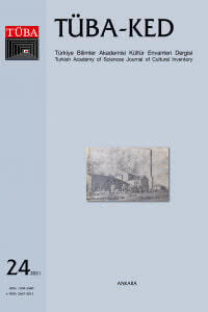TARİHSEL DOKUDA SOSYAL DEĞİŞİME DUYARLI BİR SAĞLIKLAŞTIRMA MODELİ; PATLICANLI YOKUŞU-İZMİR
Tarihi çevre koruma, sağlıklaştırma modeli, sosyal değişim, yaşam kalitesi, sosyal-kültürel sürdürülebilirlik, İzmir - Patlıcanlı Yokuşu.
A REHABILITATION MODEL RESPONSIVE TO SOCIAL CHANGES IN HISTORIC DISTRICTS: PATLICANLI YOKUŞU-İZMİR
Preservation of the historic environment, rehabilitation model, social change, quality of life, social-cultural,
___
- ARAOZ, G. F. 2011. Preserving heritage places under a new paradigm, Journal of Cultural Heritage Management and Sustainable Development 1 (1), 55-60.
- ASHWORTH, G. J. 1992. Heritage and tourism: An argument, two problems and three solutions. İçinde C.A.M. Fleischer van Roojen (Der.), Spatial Implications of Tourism (ss. 95-104). Groningen: Geo Pers.
- ASHWORTH, G. J. / TUNBRIDGE, J. E. 1990. The tourist-historic city. London: Belhaven.
- CASANOVAS, X. 2008. Rehabilitation and social action in Mediterranean old cities: Reuse of traditional architecture and social topics on an urban scale: Ciutat Vella, Barcelona. İçinde Yao Yuan, Chen Wei, Severine Calza, Rosemary Wilthshire Romero (Der.) Balanced urban revitalization; For social cohesion and heritage conservation, UNESCO International Seminar, (ss. 73-77). Tsinghua University, 21-23 January 2007, Human Settlements and SocioCultural Environment No.60, Paris: United Nations Educational, Scientific and Cultural Organization.
- COUNCIL OF EUROPE 2005. Framework convention on the value of cultural heritage for society [Avrupa konseyi toplum için kültürel mirasın değeri çerçeve sözleşmesi], Treaty series no.199. Faro: 27.10.2005.http://conventions.coe.int/Treaty/EN/ Treaties/Word/199.doc
- DEMPSEY, N. / BRAMLEY, G. / SINEAD, P. / BROWN, C. 2011. The social dimension of sustainable development: Defining urban social sustainability, Sustainable Development 19, 289-300.
- DUMITRU, A. / LEMA-BLANCO, I. / GARCIA MIRA, R. 2016. Social learning for transformative social innovation, TRANSIT Deliverable 2.3. TRANSIT:EU SSH.2013.3.2- 1 Grant Agreement n.613169.
- KEARNS, A. / FORREST,R. 2000. Social cohesion and multilevel governance, Urban Studies 37, 995-1017.
- MADDEN, K. / WILEY-SCHWARTZ, A. / ANTOSHAK, A. 2010. How to turn a place around: A handbook for creating successful public spaces. 6. Basım, New York: Project for Public Spaces.
- NASH, V. / CHRISTIE, I. 2003. Making sense of community. London: Institute for Public Policy Research.
- ÖDEKAN, A. 2013. Tarihi çevre koruma bilim mi, icraat mı? İçinde K.K Eyüpgiller, Z. Eres (Der.), Mimari ve Kentsel Koruma, (ss.233-242), İstanbul: YEM.
- SMITH, N. / WILLIAMS, P. 2015. Kentin mutenalaştırılması, (Çev. Melike Uzun), İstanbul: Yordam Kitap.
- TIESDELL, S. / ÖC, T. / HEATH, T. 1996. Revitalizing historic urban quarters, New York: Routledge.
- TÜRKOĞLU, H. / KORAMAZ, E.K. 2012. Yaşam kalitesi ve kentsel yeşil alanlar. İçinde Melih Ersoy (Ed.), Kentsel planlama ansiklopedik sözlük, İstanbul: Ninova Yayınları.
- ŞEN, B. 2011. İstanbul tarihi kent merkezinde kentsel dönüşüm: Mekânsal müdahaleye ‘içerden bakış’ ya da mekânsalı toplumsalla birlikte düşünmek, Toplum ve Demokrasi 11, 33-52.
- ŞİŞMANYAZICI, B. / YILDIZ, H. T. 2010. Tarihî kentsel alanlarda “toplumsal ve mekânsal yeniden yapılanma”: Fener ve Balat örneği, Mimarlık Dergisi 352, Ankara: Mimarlar Odası Yayını.
- ISSN: 1304-2440
- Yayın Aralığı: 2
- Başlangıç: 2003
- Yayıncı: Türkiye Bilimler Akademisi
CUMHURİYET DÖNEMİNDE TÜRKİYE VE ANKARA’DA TENİS: CAMİA VE MEKAN OLARAK BİR SPORUN YÜKSELİŞİ
ESKİŞEHİR’DE MODERN HAFIZANIN YEREL İZLERİ
LİSEDEN MÜZEYE, EĞİTİMDEN TÜKETİME; KAYSERİ LİSESİ’NİN MİLLİ MÜCADELE MÜZESİ’NE DÖNÜŞÜMÜ
MANİSA, GÖKTAŞLI CAMİ’NİN GÜNCEL KORUMA DURUMUNUN DEĞERLENDİRİLMESİ
Suna BÜYÜKKILIÇ KOŞUN, Mine HAMAMCIOĞLU TURAN
TARİHSEL DOKUDA SOSYAL DEĞİŞİME DUYARLI BİR SAĞLIKLAŞTIRMA MODELİ; PATLICANLI YOKUŞU-İZMİR
Feyzal AVCI ÖZKABAN, H.Evren ERDİN, DENİZ GÜNER, HAYAT ZENGİN ÇELİK, HÜMEYRA BİROL AKKURT
